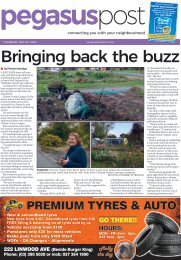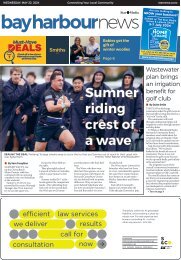The Star: July 27, 2023
Create successful ePaper yourself
Turn your PDF publications into a flip-book with our unique Google optimized e-Paper software.
Latest Canterbury news at starnews.co.nz<br />
Thursday <strong>July</strong> <strong>27</strong> <strong>2023</strong> <strong>The</strong> <strong>Star</strong><br />
NEWS 9<br />
the Vildebeest reunited<br />
“We can’t thank the Subritzky<br />
family enough for this. <strong>The</strong>y’ve<br />
made astonishing progress on<br />
the Vincent, and we are hoping<br />
we can learn a lot from what has<br />
been done.”<br />
<strong>The</strong> Vildebeest has been in the<br />
museum’s collection for more<br />
than 20 years, along with minor<br />
components from other similar<br />
planes.<br />
<strong>The</strong> restoration team has been<br />
searching the world for drawings<br />
and reference material about the<br />
plane and has gathered as much<br />
information as possible.<br />
While air publication guides<br />
provide an overview of the plane,<br />
no detailed engineering drawings<br />
remain, leaving the team with<br />
little information to complete the<br />
work.<br />
<strong>The</strong> Vildebeest first entered<br />
service with the Royal Air Force<br />
in 1932 and the Vincent in 1934.<br />
<strong>The</strong> aircraft share the same<br />
engine – a Bristol Pegasus.<br />
<strong>The</strong> main difference is the<br />
Vildebeest’s torpedo bay was<br />
replaced in the Vincent with an<br />
auxiliary fuel tank.<br />
<strong>The</strong> museum’s NZ102 was<br />
one of 12 brand-new Vildebeest<br />
torpedo bombers given to the<br />
Royal New Zealand Air Force in<br />
1935.<br />
Another <strong>27</strong> ex-RAF aircraft<br />
were given to the RNZAF in<br />
TAKE OFF: <strong>The</strong> Vildebeest NZ102.<br />
PHOTO: MAX SMITH PERSONAL COLLECTION<br />
1940-41, making a total of 39. <strong>The</strong><br />
RNZAF operated 62 Vincents<br />
alongside the Vildebeests.<br />
<strong>The</strong> NZ102 has a fascinating<br />
service history. On May 2, 1938, a<br />
young Nelson-born pilot named<br />
Leonard Trent took the controls<br />
of NZ102 during his training.<br />
Trent flew in the plane as a pilot<br />
or passenger 13 times.<br />
He went on to serve with<br />
distinction in World War 2 as a<br />
senior Royal Air Force officer. He<br />
was awarded the Victoria Cross<br />
in 1945.<br />
On February 23, 1939, a young<br />
trainee pilot named David ‘Sealy’<br />
Clark was ordered to fly solo in<br />
NZ102 and climbed to 15,000 feet<br />
for 30 minutes. On descending,<br />
he forgot to pump the brakes<br />
and noticed the brake pressure<br />
gauge was a little off. A perfect<br />
landing was soon compromised<br />
by the failure of the wheels to<br />
rotate, sending NZ102 into a slow,<br />
undignified somersault onto its<br />
back. Clark was uninjured.<br />
<strong>The</strong> rarity and historical<br />
significance of the Vildebeest<br />
means it is one of the most<br />
important military aircraft held<br />
in a museum collection anywhere<br />
in New Zealand.<br />
• <strong>The</strong> Vildebeest first flew<br />
in 1928, but by the time<br />
WW2 broke out it was<br />
obsolete.<br />
• During its time with the<br />
RNZAF, the Vildebeest was<br />
for coastal defence, general<br />
reconnaissance, aircrew<br />
training and target towing.<br />
• Its 635-horsepower Bristol<br />
Pegasus engine gave it a<br />
top speed of 230km/h.<br />
• <strong>The</strong> Vildebeest had a<br />
range of 2010km and an<br />
absolute ceiling of 19,000ft.<br />
• Its crew consisted of a<br />
FAST FACTS<br />
pilot, navigator and an<br />
observer.<br />
• It was armed with a fixed<br />
forward firing .303 Vickers<br />
machine gun and a flexible<br />
rearward firing .303 Lewis<br />
gun.<br />
• It could carry 500kg of<br />
bombs or a single torpedo.<br />
• <strong>The</strong> British Air Ministry<br />
insisted manufacturers had<br />
to name torpedo bombers<br />
after mammals. Vickers<br />
aircraft names started with<br />
a ‘v’ – and so the name<br />
Vildebeest was coined.<br />
CAREFUL: <strong>The</strong> Vickers Vincent, on loan from the Subritzky<br />
family, was moved into the museum’s Wigram hangar.<br />
Unwell?<br />
Go to your pharmacy for advice, medicine or<br />
referral for minor health conditions<br />
This winter, Te Whatu Ora is funding free help for minor health conditions at<br />
participating community pharmacies in Waitaha Canterbury.<br />
For eligibility criteria and more information visit<br />
www.cdhb.health.nz/minorhealthconditions or talk to your pharmacist.


















